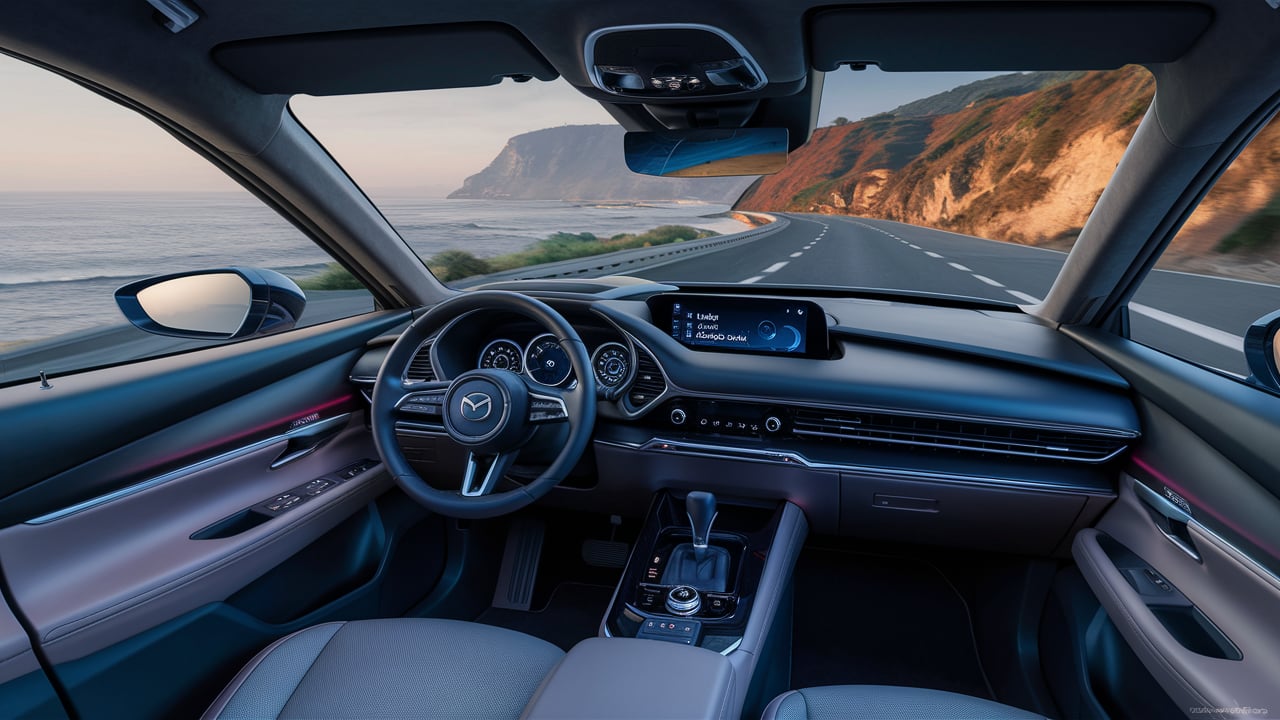The future of driving is on the horizon, and Mazda, a brand known for its commitment to innovation and driver-centric design, is actively shaping it with its “Mazda autonomous driving.” In this post, Supercar Info will delve into the key features of the Mazda self driving car, its human-centric approach, and how it aims to enhance the driving experience while ensuring driver safety.
The Technology Behind Mazda autonomous driving
Driver Monitoring System: Keeping an Eye on the Driver
Mazda’s Co-Pilot Concept is built on a foundation of advanced driver monitoring technology. This system utilizes cameras and sensors to constantly assess the driver’s state, looking for signs of fatigue, distraction, or sudden incapacitation. If the system detects a potential issue, it can intervene to help prevent accidents.
Advanced Safety Features: A Shield of Protection
Beyond driver monitoring, the Co-Pilot Concept incorporates a suite of advanced safety features designed to enhance driver awareness and mitigate risks. These features include:
- Lane-Keeping Assist: Helps keep the vehicle centered in its lane, gently steering it back if it starts to drift.
- Adaptive Cruise Control: Maintains a safe distance from the vehicle ahead, automatically adjusting speed to maintain a set following distance.
- Automatic Emergency Braking: Uses sensors to detect potential collisions and automatically applies the brakes to help avoid or mitigate the impact.
- Blind Spot Monitoring with Rear Cross Traffic Alert: Helps drivers detect vehicles in their blind spots and warn them of oncoming traffic when reversing.
Emergency Takeover System: Stepping in When Needed
In the event of a driver becoming incapacitated, the Co-Pilot Concept has an emergency takeover system. If the system detects that the driver is unable to control the vehicle, it can automatically decelerate and bring the vehicle to a safe stop. The system can also unlock the doors and call for emergency assistance.
The Benefits of Mazda self driving car
Enhanced Safety: A Focus on Prevention
The Co-Pilot Concept is designed to enhance safety by proactively monitoring the driver and the surrounding environment. The driver monitoring system helps prevent accidents caused by fatigue, distraction, or sudden incapacitation, while the advanced safety features provide an extra layer of protection in challenging driving situations.
Improved Driving Experience: A More Confident and Relaxed Drive
The Co-Pilot Concept aims to improve the driving experience by reducing stress and fatigue. Features like adaptive cruise control and lane-keeping assist take some of the burden off the driver, allowing them to focus on the road ahead and enjoy the journey. The system’s human-centric approach ensures that the driver remains in control, but with the added assurance of assistance when needed.

Peace of Mind: Knowing You’re in Safe Hands
The Co-Pilot Concept provides peace of mind for drivers and their passengers. Knowing that the system is constantly monitoring the driver and the environment, and that it can intervene in emergencies, gives drivers a sense of security and confidence. This peace of mind allows drivers to focus on enjoying the drive, knowing that they have a safety net in place.
What are the limitations of Mazda’s Co-Pilot?
Mazda’s Co-Pilot, a suite of advanced driver-assistance systems (ADAS), offers a range of features to enhance safety and convenience. However, it’s important to understand its limitations:
Level of Autonomy
- Not Fully Autonomous: Co-Pilot is not a self-driving system. It requires constant driver attention and intervention. The driver remains responsible for controlling the vehicle at all times.
- Limited Functionality: While Co-Pilot offers features like adaptive cruise control, lane keep assist, and blind spot monitoring, it doesn’t provide complete control over the vehicle in all situations.
Environmental Limitations
- Weather Conditions: Co-Pilot’s performance can be affected by adverse weather conditions like heavy rain, snow, or fog. Its sensors might struggle to detect road markings or obstacles in such situations.
- Road Conditions: Co-Pilot relies on cameras and sensors to function effectively. It may not work as well on poorly maintained roads, roads with uneven surfaces, or roads with limited visibility.
- Traffic Density: In extremely dense traffic, Co-Pilot’s features might not operate optimally. It may struggle to maintain a safe distance or react quickly to sudden changes in traffic flow.
System Limitations
- False Positives: Co-Pilot’s sensors can sometimes misinterpret information, leading to false alarms or unintended actions.
- Over-reliance: Drivers should not become overly reliant on Co-Pilot and should always be prepared to take control of the vehicle if necessary.
- Software Updates: Co-Pilot’s functionality and performance can be affected by software updates. It’s essential to keep the system updated for optimal operation.
User-Specific Limitations
- Driver Familiarity: Co-Pilot’s features require some time to learn and adapt to. Drivers need to be familiar with the system’s capabilities and limitations.
- Individual Preferences: Some drivers may find certain Co-Pilot features intrusive or distracting. It’s important to adjust the system’s settings to individual preferences.
In conclusion
Mazda Autonomous Driving is a promising technology that holds the potential to revolutionize the way we drive. While still in its early stages of development, it offers a glimpse into a future where driving is safer, more efficient, and more enjoyable. As Mazda continues to refine and improve its autonomous driving systems, we can expect to see even more innovative features and capabilities emerge, ultimately leading to a more connected and seamless driving experience.

Related Posts
Mercedes Cruise Control: A Comfortable Journey, A Luxurious Experience
Types Of Pickup Trucks | Conquer Challenging Roads
Types Of Mustangs: A Journey Through Ford’s Iconic Muscle Car